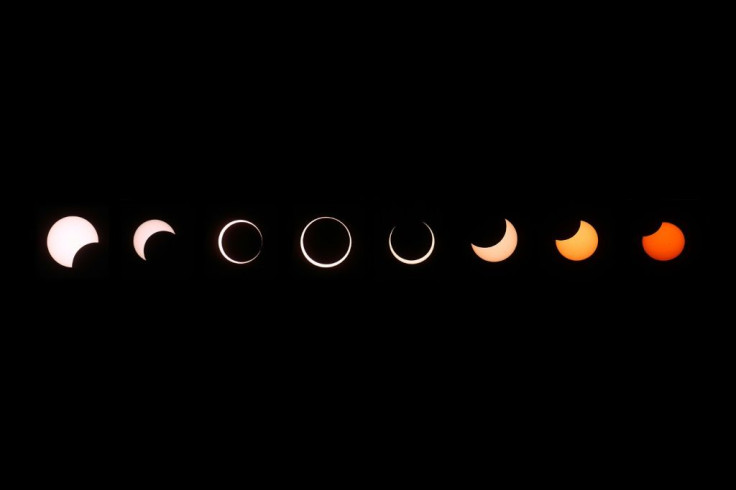'Ring of Fire': Where, How To Watch This Week's Annular Solar Eclipse
KEY POINTS
- A "ring of fire" solar eclipse will take place Thursday
- Parts of the U.S. will witness a partial eclipse
- Those who will watch it should use proper eclipse glasses
A "ring of fire" solar eclipse will grace the skies this week, and it will be visible from some parts of the U.S.
An annular solar eclipse is set to happen Thursday. Also called the "ring of fire" eclipse, this sky event will take place when the moon passes directly between the Earth and the sun. However, the moon will appear smaller because it will be "far enough away" from the Earth, so it will instead create a ring of light around the moon, NASA explained.
People in parts of the northern hemisphere will get to watch the spectacle, including those in parts of Canada, northern Russia and Greenland.
Meanwhile, others will also witness a partial eclipse and see a dark shadow being cast over the sun, making it look rather like the moon took "a bite" out of it. Those who will witness a partial eclipse will see a crescent-like shape instead of a ring of fire.
They include those in parts of the U.S, parts of the Caribbean, Asia, Europe, much of Canada and northern Africa. In the U.S., the sky event will be visible in Northern Alaska, in the Southeast, Midwest and Northeast.
It’s #SunDay! People in the northern hemisphere may be able to see an eclipse of the Sun on June 10. A ‘ring of fire’ solar eclipse will be visible in parts of Canada & the Arctic, and a partial eclipse elsewhere, including part of the eastern US & Alaska. https://t.co/MN6D3L6tAt pic.twitter.com/4NL6xYZsgW
— NASA Sun & Space (@NASASun) June 6, 2021
The eclipse will happen from 4:12 a.m. ET to 9:11 a.m. ET, The Old Farmer's Almanac noted. This means that the eclipse will be a sunrise event for skywatchers in the U.S. but a lunchtime event for those in Europe. In the Washington D.C. area, for instance, people will see the sun getting blocked by 80% as they rise at 5:42 a.m.
Thursday's event will be the first solar eclipse in the continental U.S. since 2017's total solar eclipse, according to the American Astronomical Society.
How to safely watch Thursday's solar eclipse
Keep in mind that this week's sky event is a solar eclipse and, as an annular eclipse, there won't be a moment when the sun will be completely obscured by the moon. So those who will watch the eclipse live should wear proper protective eclipse glasses.
"It is never safe to look directly at the Sun's rays, even if the Sun is partly or mostly obscured," NASA said. "Solar viewing or eclipses glasses are NOT regular sunglasses; regular sunglasses are not safe for viewing the Sun."
Those who still have a pair of eclipse glasses should use them while watching the eclipse, while others may also choose to create a pinhole viewer that will let them project the sunlight onto a surface to see the eclipse without really looking at it.
One can create it by using a cereal box, a piece of paper, scissors, aluminum foil, tape and something to poke the pinhole with. NASA has provided simple and quick instructions on how to make one here.

© Copyright IBTimes 2024. All rights reserved.






















